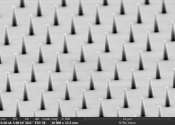GRAIL creates most accurate Moon gravity map (w/ video)
(Phys.org)—Twin NASA probes orbiting Earth's moon have generated the highest resolution gravity field map of any celestial body.

(Phys.org)—Twin NASA probes orbiting Earth's moon have generated the highest resolution gravity field map of any celestial body.
Space Exploration
Dec 5, 2012
8
0

EPFL researchers have discovered that symmetry in the human body is influenced by surface tension, the same mechanical phenomenon that allows lightweight insects to walk on water. A paper discussing this surprising finding, ...
Biotechnology
May 6, 2022
0
16

Microplastics in soil are extremely diverse and complex. This makes it difficult to determine the risks of plastic pollution to soil life, which is an increasing concern among policymakers and scientists. Researchers from ...
Environment
Feb 13, 2024
0
68

If you or I jump in the air as high as possible, we can stay off the ground for about half a second. Michael Jordan could stay aloft for almost one second. While there are many events at the Winter Olympics that feature athletes ...
General Physics
Feb 10, 2022
0
79

Between 1969 and 1972, a new type of archaeological site was created. For the first time, human bodies and the technology needed to sustain them altered the landscape of another world. The astronauts from the six Apollo missions ...
Space Exploration
Mar 29, 2019
0
13

When biologists study cells under a microscope, they look at them on flat surfaces that are nothing like the environment inside the human body. Now, researchers at NTNU have found a way to mimic some aspects of a cell's native ...
Bio & Medicine
Feb 9, 2022
0
36

A collaborative team of scientists led by the University of Massachusetts Amherst recently found that there is no physiological evidence supporting a leading theory—which involves the surface area of fish gills—as to ...
Plants & Animals
Feb 21, 2024
1
226

A research team from ETH Zurich and the Max Planck Institute for Solar System Research in Göttingen counted over 136,000 rockfalls on the moon caused by asteroid impacts. Even billions of years old landscapes are still changing.
Space Exploration
Jun 8, 2020
0
183

Programmed cell death, or apoptosis, occurs tens of millions of times every day in every human body. Researchers in South Korea have devised an easy method to detect apoptotic cells by fluorescence, as they report in Chemistry—An ...
Biochemistry
Jan 25, 2013
0
0

New research published in the Journal of Natural History indicates that zebras' stripes are used to control body temperature after all—and reveals for the first time a new mechanism for how this may be achieved.
Plants & Animals
Jun 13, 2019
0
34